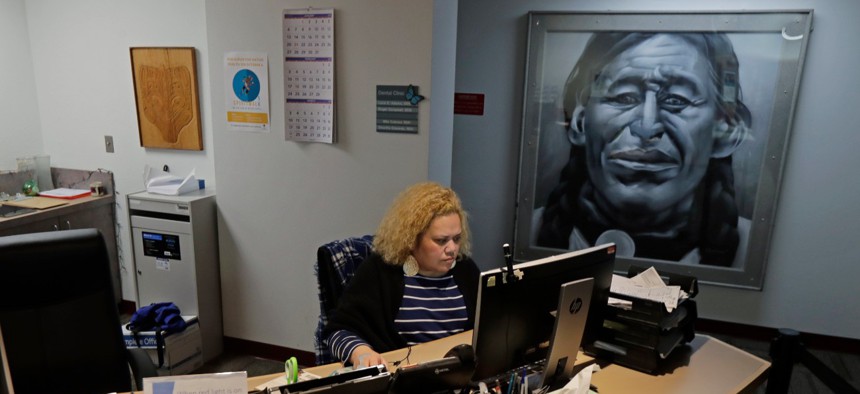
Nia Tagoai, a patient scheduler at a clinic in Seattle in January 2019. Ted S. Warren/AP
Indian Health Service Expands Telehealth During the Coronavirus
The agency and Native populations face unique health and technology challenges, however.
On Wednesday, the Indian Health Service announced it expanded electronic health services nationwide for its facilities serving native Americans who are uniquely vulnerable to the novel coronavirus pandemic.
IHS, a division of the Health and Human Services Department, provides health services for about 2.6 million American Indians and Alaska Natives who belong to 574 federally recognized tribes across 37 states. The Trump administration has been boosting telehealth during the pandemic to adhere to the Centers for Disease Control and Prevention’s guidelines on social distancing. Now it’s expanding such efforts for Native populations, which have a history of vast health disparities and, thus, vulnerability to the coronavirus.
“Expanding telehealth allows more American Indians and Alaska Natives to access healthcare they need from their home, without worrying about putting themselves or others at risk during the COVID-19 pandemic,” said HHS Secretary Alex Azar in a press release on Wednesday. “Thanks to regulatory flexibility and hard work by IHS, providers will be allowed to use everyday technologies to hold appointments with their patients. Telehealth options ensure that heroic frontline IHS providers who may be under stress from responding to COVID-19 have maximum flexibility to provide the care patients need.”
IHS issued initial guidance on March 27 to allow its facilities to use the platform Cisco Meeting to treat patients during the pandemic. The system is not new to IHS, but now it’s expanding the use across its facilities. “Beginning [Wednesday], IHS service units and their clinicians who are using the system will obtain verbal consent from patients who meet with their provider via a telehealth appointment,” the agency said. “Health care providers are required to verify the patient at the beginning of each encounter and are not authorized to record the session.”
Last week, IHS did a pilot test at six of its sites in the Oklahoma City and Navajo areas. Now, the agency is training more employees on how to use the system. The “effort [is] building on an existing telebehavioral health program and provides a platform for providers to connect to patients,” IHS Chief Information Officer Mitchell Thornbrugh told Government Executive. “We also have facilities using video conferencing inside their facility to reduce [personal protective equipment] usage associated with screening patients onsite.”
Due to the remote locations of many IHS facilities and the populations they serve, access to technology—and more fundamentally, to broadband—is a major challenge, however. A May 2019 report by the Federal Communications Commission found that tribal lands have lower rates of both fixed and mobile broadband access than elsewhere in the United States, and the problem is particularly acute in rural areas:
“While 92% of housing units on urban tribal lands are covered by a fixed terrestrial provider of 25/3 Mbps broadband service—just six points behind their non-tribal urban counterparts—just 46.6% of housing units on rural tribal lands have access to that service, a nearly 27-point gap compared to non-tribal rural areas. Mobile LTE coverage on tribal lands is similarly behind deployment on non-tribal lands; while 99.8% of the population living on non-Tribal areas are covered by mobile LTE service, only 96% of the population living on Tribal land are covered with such service.”
The expansion of telehealth comes as Thornbrugh’s office is engaged in a “massive undertaking” to modernize a 50-year-old health care system, as NextGov reported in February.
“We are acutely aware of the lack of broadband,” Thornbrugh told Government Executive. “We rely on the Federal Communications Commission broadband studies to document our needs generally.”
The spread of the coronavirus is compounding IHS’ challenges. According to the most recent data on IHS’s tracker, as of April 8, there were 741 positive coronavirus cases reported from IHS, tribal, and urban Indian organization facilities.
“Tribal communities are among the poorest and most vulnerable in the United States. On some reservations, life expectancy is lower than in some Third World countries,” Bryan Newland, president of the Bay Mills Indian Community, a federally recognized tribe of Ojibwe people in northern Michigan, wrote in The Washington Post on March 25. “Our interconnections and informal care networks ordinarily allow members of tribal communities to make ends meet. But they make us vulnerable to the spread of the coronavirus and put us at greater risk when our social safety net is severed.”
IHS recently posted dozens of job openings that could aid its coronavirus response. Additionally, the $2.2 trillion CARES Act gave IHS over $1 billion for various health programs, electronic health records support and other discretionary uses during the pandemic.
On Thursday, the National Indian Health Board Chair and Winnebago Tribal council member Victoria Kitcheyan applauded the funding in an interview on C-SPAN. She would like to see continued “flexibility” in future stimulus packages, so “tribes can be unique in their approach and solutions” to the virus. “We came into this pandemic underserved,” she noted.
“Health care on Native American reservations has been notoriously poor … since the reservations and the health care system was set up literally in the 1800s,” Rutgers University Professor Camilla Townsend, who specializes in early Native American and Latin American History, told Government Executive. “The reservations themselves were always on the poorest land in each state” and had “not nearly enough of healthcare offices or doctors spread over vast rural areas.”
The “extraordinary irony here” is that the coronavirus outbreak is occurring “500 years to almost the day” from “the spring of 1520 when the first big smallpox epidemic was started,” among the Native population, she stated.
NEXT STORY: Viewpoint: Treat It and Beat It







